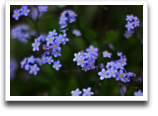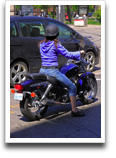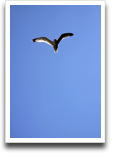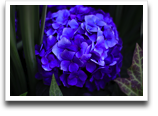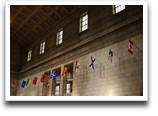Blue is not a popular colour in downtown Toronto. There are blue awnings— The King Edward Hotel, and Young Thailand restaurant— some blue cabs, but otherwise, the city is bereft of blue. Yellow seems to be the most popular color in the city.

This journal documents my experiences with a Canon 50D, my first DSLR camera, purchased on Oct. 16, 2008. It is a showcase for my photography, includes comments about the camera's usability, with suggestions for improvement and discusses photography-related topics.
Blue
photos
Review: "The Photography Book"
book review
My
review of The Photography Book. I rated it 2.5++ out
of 4.

Happy Canada Day
photo
To commemorate Canada Day, I browsed through my Seagate Free Agent drive for a photo with the Canadian flag and I was surprised to see this one I took at Union when I first got my 24-105 lens; the inclusion of the provincial flags is rather apropos.
I wasn't thinking of composition when I photographed the flags; it
was just a photo with my new lens.

Friday Foto: Wet Ivy
photo
 |
| FromFriday Foto |
Today's Friday Foto (50mm lens, f/2.0, 1/60s, ISO 125) is from a set photographed when I took my camera out on a rainy day. I got a few drops of water on my camera from standing under this tree to photograph the wet ivy.
I should have used a smaller aperture (f/7.1?) to get more of the leaves looking sharp. (I am linking directly to the Picasa album.)

By Any Other Name
I wondered if there was an established name by which Canon lovers and Nikon lovers referred to themselves. I Googled for my guesses to ascertain the term's popularity. Here are my results:
| Term | Search results |
|---|---|
| Canonistas* | 722,000 |
| Canonians | 137,000 |
| Canoners | 3,830 |
| Nikonians | 521,000 |
"Canonistas" is starred because it's primarily a spanish-oriented term/site; in view of this term's overwhelming popularity, however, I propose we call ourselves "Canonistas".
"Nikonians" seems to be the established term for Nikon lovers (though I didn't search for other terms).
People who love both Canon and Nikon should probably be called
Rockwellians (thanks to <Sketch> for posting the link in ##cinema and reminding me of that article).

Shooting "The Godfather"
gear cinema
An article about the computer controlled zoom lens used to shoot the opening 3 minutes of "The Godfather"; it's the only zoom shot in the entire movie.

Canon Editor's Choice
Editor's Choice is a feature on Canon's Professional Network Europe website that invites Canon photographers to submit their photos to be critiqued by a photo editor.
This is not a photo contest so I am thinking of submitting one of my Friday Fotos due to the lack of stress normally involved in a contest.

Friday Foto: Pink and yellow tulips
photo
But the heavens and the earth, which are now, by
the same word are kept in store, reserved unto fire against the day
of judgment and perdition of ungodly men.
KJV, 2 Peter 3:7
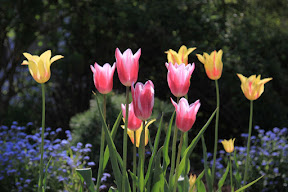 |
| FromFriday Foto |
24-105/4L at 60mm, f/4, 1/800s, spot metering, ISO 100
Unless photographing a sunset, the photographer always keeps the sun behind their back so the subject remains illuminated. Today's Friday Foto breaks that rule. In this case, the sun is behind and above the flowers, and the background is in deep shadow giving greater contrast.
The first time I used this technique was to photograph the red tulips at St. James Cathedral.
Update Fri Jul 10 22:24:06 2009: This evening, during my commute home, I was reading John R. Holmes' review of Pynchon's Against the Day whereupon I came across the following passage:
The interplay of religion, physics and the material world may well be best summed up by Pynchon's choice of title for his sixth novel. Against the Day suggests an apocalyptic idiom from the King James Bible, 2 Peter 3:7 but also a photographic term that has implications for modern physics and non-Euclidian geometry. In the techinique that early French photographers called contre-jour, "against the day", cameras shot into the light source, reducing foreground objects into two-dimensional outlines...
A Milestone: For the first time since the creation of this journal, visits from Canada (144) have exceeded visits from the U.S. (135) for the past 30 days. The rest of the countries with ten or more visitors are the U.K. (28) and Australia (13).

"Apocalypse Now" Cameras
cinema
You're an errand boy, sent by grocery clerks, to
collect a bill.
—Col Kurtz
There are are a few scenes where photographers appear in Apocalypse Now: the first scene is the introduction of Col. Kilgore during mop-up operations in a village being evacuated— a female photographer photographs Kilgore; the other scene is when Willard meets The Photographer (played by Dennis Hopper, allegorically, he is the Cyclops as he only "sees" with one eye) just after they sail into Kurtz's compound.
Note that both screencaps have been colour-corrected by removing the "yellow" tint added to resemble sunset. According to the IMDB trivia page, "The character of the photojournalist (Dennis Hopper) was reportedly inspired by legendary photographer Tim Page, author of Nam and Derailed in Uncle Ho's Victory Garden, among others."
Based on the images on this Nikon History page, noted by <popsicle> on ##cinema, the four cameras that The Photographer carries, are Nikon F models and the one on his side has a motor winder attachment ("but it's most likely Fs. most of the F2s and later didn't have the characteristic triangular shape of the top, they were flattened. at least from what I can figure after some quick searches").

Hasselblad Space Cameras
gear
As the 40th anniversary of the Moon landing approaches, it should be noted that Hasselblad cameras were used by NASA to document the achievements of Man's first steps into space and on the moon. It seems the choice of brand was quite arbritrary:
The Hasselblad 500C, with a planar 80mm lens (modified), was the first Hasselblad camera to be used by NASA in space. It was purchased by the astronaut Walter M. Schirra from a camera shop in Houston, Texas.
Modification, carried out by NASA, involved removing the lining, mirror, focusing screen and hood, among other things, to make the camera lighter.
Update Wed Jul 15 15:29:36 2009: The Big Picture has a feature on the Apollo 11 mission. David sent a link to a longer article on Hasselblad cameras. Wed Jul 15 16:31:57 2009: LIFE magazine has a feature on the private lives of the astronauts, photographed by Ralph Morse.

Depth of Field Calculator
technique
Canon's CPN website has an online DOF calculator. You input the camera model, the aperture, the focal length and the focus distance and it calculates the near and far limits of focus, total depth-of-field and hyperfocal distance.
This seems a bit too "left-brain" for me; my boss was looking for something like this and he is very left-brain (logic triumphs over creativity). His assumption logic is that if the camera can expose a scene "perfectly", then it must be using an algorithm of some sort based on physics and mathematics, so if he figured out this algorithm, then he should also be able to expose a scene perfectly. I told him that the camera likely has a huge look-up table that matches the current sensor report to a scene and the camera sets itself according to the closest match (but this could just be my ignorance speaking).
I prefer the right-brain approach— try something and see how it looks, then change it and see how it looks, etc.— which allows for creative accidents, resulting in more interesting results. Of course, it takes much longer to get things "right" this way, but I have given myself 10 years to learn photography.
Fri Jul 17 23:14:07 2009: David responded:
Another DOF Calculator that has pictures, so it's easier to see what the numbers for near and far limits, etc. actually would correspond to. It also handles a bunch more cameras. The site also has an iPhone web app, as well as native iPhone app versions.
If you want to understand exposure I'd recommend the book "Understanding Exposure" by Brian Peterson. It gives you the basic of how things work, without messing you up with equations and such. It also has assignments / projects that you can do to understand how things work. The first addition was written the pre-digital days of 1995, and even the updated version (2004) doesn't assume any auto-magic stuff on recent dSLRs.
The book is highly recommended by a lot of people, but there are places that can give you some rules of thumb on exposure (e.g., "sunny 16" rule).
As for how the exposure on cameras is calculated, the book explains that as well, but there are simple introductions on the matter online. It's a balancing act between ISO, shutter speed, and aperture (the "exposure triangle") to ensure that enough light gets in (it's zero- sum to some extent).
Adjusting one value will affect the properties of the photograph (DoF, grain, mothion blur), and will cause the others to be affected as well. This you probably know of course. :) The "correct" exposure is the one that achieves the image that you want.

Julius Shulman, R.I.P.
photographer
He was so proficient at his craft that he was
known as "one-shot Shulman".
—Philip Ethington
Julius Shulman, photographer of modern architecture in California, passed away today, aged 98. His most famous photograph is Case Study House No. 22:
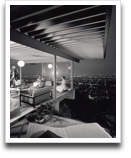
To capture the image in the camera, however, Shulman had to essentially take two photographs at once -- one of the vista below, which required a time exposure, and one of the house, which required a flash.
Working quickly and without a light meter, Shulman shot a 7½-minute exposure of the city lights with his 4-by-5 camera.
"Then, when I felt I had given enough time for the exposure, and I wanted to flash the interior, I called to the girls," Shulman told Taina Rikala De Noriega for the Archives of American Art/Smithsonian Institution. "I said, 'Girls, sit up now and look pleasant. Look toward each other as if you're talking and hold still for just a second and the flash will go off.' I pressed the release. All this time the shutter was open and the flash illuminated the interior."

Friday Foto: Pink Flowers with Blue Centers
photo
 |
| FromFriday Foto |
Taken with the Canon S60, a $500 point-and-shoot camera, as proof that you can take good photographs with practically any camera. What is far more important than equipment, is reading the camera manual and understanding how to operate the camera in different situations.

New IS Canon Lens Coming
gear
Canon will introduce a new lens before the end of 2009 which will incorporate a Hybrid Image Stabilizer, which compensates for two types of camera shake simultaneously.
From the article it will likely be a macro lens. But this doesn't
discount the introduction of the IS 24-70mm.

Friday Foto: Forest Panorama
photo
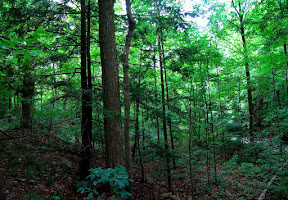 |
| From Friday Foto |
Two-photo panoramic image stitch (you can see the seams if you look closely) taken with the Canon S60.
There wasn't really any thought to composition in this photo— I just took two photographs in the most photogenic direction. I have some nice macro shots of the forest floor, and the insects, etc. which I will post in the future.

Moo Cards
promotion
I'm thinking of getting some Moo cards done. PhotoJoJo has a promotional link for 20% off a purchase of $20 or more.
I created a photo-related gmail account (lotsofotos) for this purpose. Now I just have to pick 50 photos.
Tue Jul 28 18:50:02 2009: 50 cards ordered. Ship date: Aug
3; delivery will be about a week later.

QuickTake 100 Digital Camera
gear
TUAW has a post about Apple's QuickTake 100 Digital Camera c. 1994.

